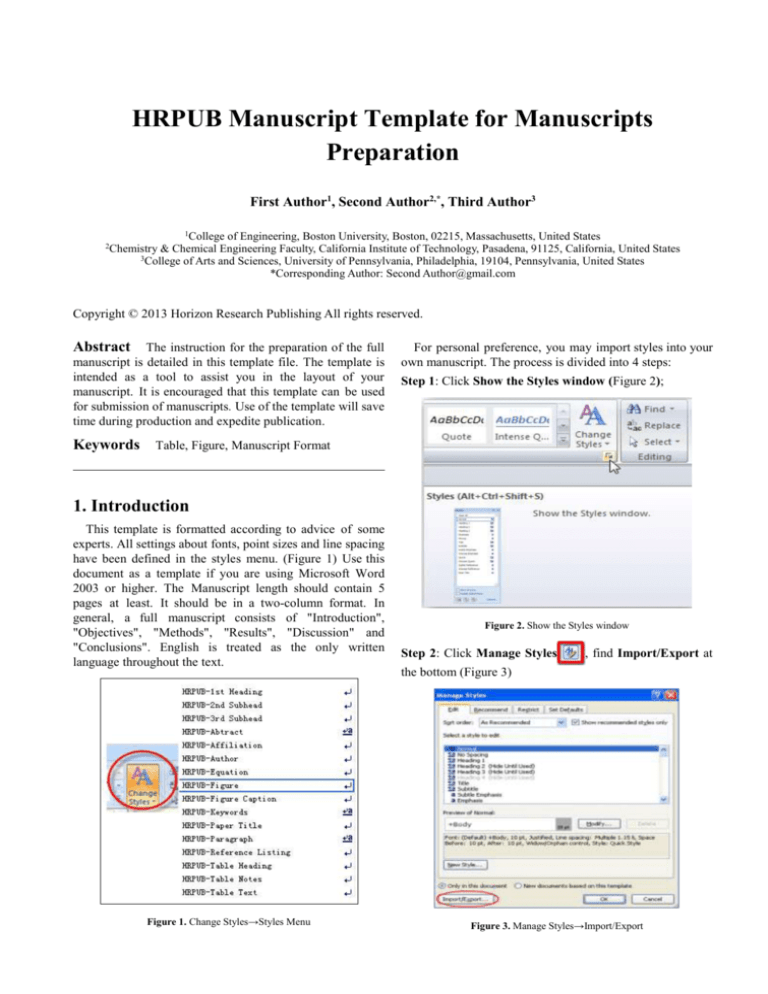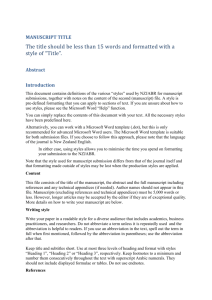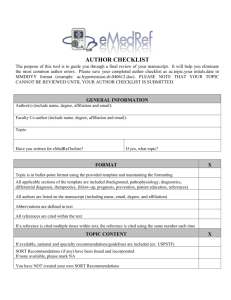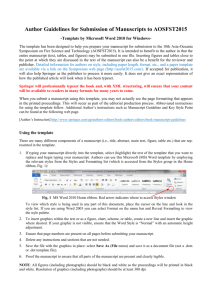
HRPUB Manuscript Template for Manuscripts
Preparation
First Author1, Second Author2,*, Third Author3
1College of Engineering, Boston University, Boston, 02215, Massachusetts, United States
& Chemical Engineering Faculty, California Institute of Technology, Pasadena, 91125, California, United States
3College of Arts and Sciences, University of Pennsylvania, Philadelphia, 19104, Pennsylvania, United States
*Corresponding Author: Second Author@gmail.com
2Chemistry
Copyright © 2013 Horizon Research Publishing All rights reserved.
Abstract
The instruction for the preparation of the full
manuscript is detailed in this template file. The template is
intended as a tool to assist you in the layout of your
manuscript. It is encouraged that this template can be used
for submission of manuscripts. Use of the template will save
time during production and expedite publication.
Keywords
For personal preference, you may import styles into your
own manuscript. The process is divided into 4 steps:
Step 1: Click Show the Styles window (Figure 2);
Table, Figure, Manuscript Format
1. Introduction
This template is formatted according to advice of some
experts. All settings about fonts, point sizes and line spacing
have been defined in the styles menu. (Figure 1) Use this
document as a template if you are using Microsoft Word
2003 or higher. The Manuscript length should contain 5
pages at least. It should be in a two-column format. In
general, a full manuscript consists of "Introduction",
"Objectives", "Methods", "Results", "Discussion" and
"Conclusions". English is treated as the only written
language throughout the text.
Figure 1. Change Styles→Styles Menu
Figure 2. Show the Styles window
Step 2: Click Manage Styles
, find Import/Export at
the bottom (Figure 3)
Figure 3. Manage Styles→Import/Export
Step 3: Copy all styles entitled with HRPUB to the
Normal.dotm and close the Organizer (Figure 4)
2.3. Abstract & Keywords
The abstract should concisely state the purpose of the
investigation and summarize the important conclusions. It
should be a single paragraph of generally no more than 200
words.
Immediately after the abstract, 3-8 words or short phrases
should be included for online searching (e.g. Keywords
Table, Figure, Manuscript Format)
2.4. Figures
2.4.1. Figures Caption
Figure 4. Copy all styles entitled with HRPUB to the Normal.dotm
Each figure should have a caption. The caption should be
concise and typed separately, not on the figure area; If
figures have parts (for example, A and B), make sure all
parts are explained in the caption.
Step 4: Open your own manuscript file, repeat Step 1-3 and
copy all styles entitled with HRPUB to your own
manuscript file.
2. Materials and Methods
Present the research design, research type, research
duration, inclusion/exclusion criteria, choice of subjects, etc.
Describe the methodology completely, including sample
collection, processing, lab analysis, statistical tests used for
data analysis etc. Use section headings/subheadings in a
logical order to entitle each category or method. A
maximum of three levels of headings may be used. Usually,
headings are numbered with Arabic numerals (1., 2.; 1.1.,
1.2.; 1.1.1., 1.2.1….). It’s preferred to illustrate with tables
and figures.
2.1. Paper Title
A paper should have a short, straightforward title directed
at general readers in no more than 20 words.
2.2. Authorship
Figure 5. Part A and Part B
List the first and last names of all authors. Provide the full
affiliation for each author including Department, University,
City, Zip Code, State, Country. If any of the co-authors are
from different organizations, their affiliation should be
numbered with different Arabic numerals. Email address is
compulsory for the corresponding author.
e.g. Josh Jacobus1, Garrett Elleithy2, Jamal Ghaly3
1
College of Engineering, Boston University, Boston, 02215,
Massachusetts, United States
2
Chemistry & Chemical Engineering Faculty, California
Institute of Technology, Pasadena, 91125, California, United
States
3
College of Arts and Sciences, University of Pennsylvania,
Philadelphia, 19104, Pennsylvania, United States
2.4.2. Figures Numbering & Citation
All figures are to be sequentially numbered with Arabic
numerals. Figures should always be cited in consecutive
numerical order. (Figure 5) Parts in a figure can be identified
by A, B, C etc. and cited as Fig. 2A, Fig. 2B, Fig. 2C. For
larger figures or tables (8.4cm≤Width≤17cm), you may put
them in one column. (Figure 6 & Table 1)
2.4.3. Figures Resolution
Figures must be created at a minimum resolution of 300
dpi to avoid bad printing quality. For fuzzy or jagged figures,
authors are required to replace it or send the original figure
file to us for reproduction.
Figure 6. A large figure in one column
Table 1. Specific data of Column/Row
Row Header 1
Row Header 2
Column Header 1
X
X
2.5. Tables
Column Header 2
X
X
Equation created by MathType:
2.5.1. Tables Title
Every table must have a unique title placed at the top.
Titles should be clear and concise, and they should not be
complete sentences.
2.5.2. Tables Format
Table tools in Microsoft Word are recommended for
inserting a table. It’s necessary to avoid tables created with
the tab key.
f ( x) a
0
(an cos
n 1
n x
n x
bn sin
)
L
L
(2)
2.6.2. Equation Numbering & Citation
Equations should be numbered consecutively with Arabic
numerals to avoid ambiguities, if they will be referred to in
text. Citation for an equation should be made by using
“(1),” not “Eq. (1)” or “equation (1),” except at the
beginning of a sentence: “Equation (1) is…”
2.5.3. Tables Numbering & Citation
Tables in the main body of the text should be numbered
consecutively according to its appearance in the text. Cite
each table in numerical order.
2.6. Equation
2.7. Appendix
An appendix may be included (and is often helpful) in
mathematical or computational modeling.
2.8. Reference Style
2.6.1. Equation Format
The equation number should be placed in parentheses to
the right of the equation. Do not create equations as pictures.
Use MathType or insert symbols as normal text.
All sources cited in text must appear in the reference list,
and all items in the reference list must be cited in text. With
the numerical system, references are arranged in the
reference list so that they match the order in which they are
cited in the text.
Equation as normal text:
E=MC2
2.8.1. Reference in-Text Citation Format
(1)
References are simply cited with the consistent reference
number in square brackets. Do not set references number as
superscript number. Do not use “Ref. [3]” or “Reference [3]”
except at the beginning of a sentence, e.g. “Reference [3]
shows …”
A. Single Reference
If the author's name appears in the text, place the
reference number immediately after the name.
E.g. Peter[10] found an innovative scientific
phenomenon.
Conference Papers
All author names, Title, Conference title, pp, Year.
e.g. A. Abiewskiro,. Z. Moplskiiera. The Problem Of
Grammar Choice For Verification, TCSET of the
International Conference, House of Lviv Polytechnic
National University, 19-23, 2008.
Websites
Online Available: http:// e.g.: Farquhar C, Protein and
DNA Music, Online available from http://www.hrpub.com
B. Multiple References
1) Put two or four numbers in numerical order and
separate them by commas but no spaces.
E.g.: [2,3]
2) Indicate three or more consecutive reference numbers
by giving the first and last numbers separated by a hyphen.
3. Conclusion
Any comments and suggestions are welcomed so that we
can constantly improve this template to satisfy all authors’
research needs.
E.g.: [3-5]
2.8.2. List of References
Acknowledgements
Authors are requested to check all references for
completeness, including author names, paper title, publisher,
journal heading, Volume, Number., pages for journal
citations, Year.
We are very grateful to experts for their appropriate and
constructive suggestions to improve this template.
Books
All author names, Book title, Publisher, Country, Year.
e.g. R. F. Voss, J. Clarke. Algorithmic Musical
Composition, Silver Burdett Press, Londyn, 1986.
Journals
All author names, Title, Publisher, Journal title, Vol, No,
pp, Year
e.g. W. Zabierowski, A. Napieralski. Chords classification
in tonal music, Journal of Environment Studies, Vol.10,
No.5, 50-53.
REFERENCES
[1]
R. F. Voss, J. Clarke. Algorithmic Musical Composition,
Silver Burdett Press, Londyn, 1986.
[2]
W. Zabierowski, A. Napieralski. Chords classification in
tonal music, Journal of Environment Studies, Vol.10, No.5,
50-53.
[3]
A. Abiewskiro,. Z. Moplskiiera. The Problem Of Grammar
Choice For Verification, TCSET of the International
Conference , House of Lviv Polytechnic National University,
19-23, 2008.
[4]
Farquhar C, Protein and DNA Music, Online available from
http://www.hrpub.org








